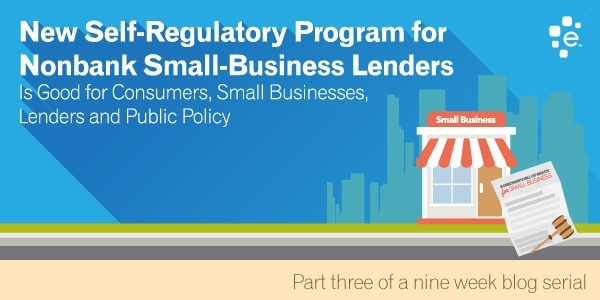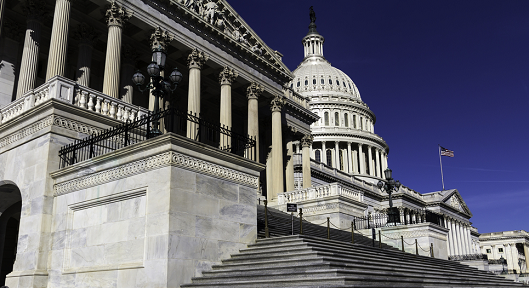Public Sector

The Responsible Business Lending Coalition — a group of nonbank small-business lenders — announced a self-regulatory program during August that is designed to bring greater clarity and consistency to its industry’s pricing and consumer protections. The Small Business Borrower’s Bill of Rights outlines six primary principles that those signing the pledge will abide by when lending to small businesses. They include: The right to transparent pricing and terms, including a right to see an annualized interest rate and all fees The right to non-abusive products, so that borrowers don’t get trapped in a vicious cycle of expensive reborrowing The right to responsible underwriting, so that borrowers are not placed in loans they are unable to repay The right to fair treatment from brokers, so that borrowers are not steered into the most expensive loans The right to inclusive credit access, without discrimination The right to fair collection practices, to prevent harassment and unfair treatment “Online loans with shorter terms, and high-priced loans have a higher degree of creating debt traps,” explained Conor French, director of legal & regulatory for Funding Circle, one of the coalition's founding members. “Borrowers in the online market need to be able to make an apples-to-apples comparison between lenders and between loans. We wanted to create a choice architecture that allows borrowers to see similar information.” Adoption of Industry Best Practices Helps Establish Clear Rules of the Road The adoption of self-regulatory standards by this group of small-business lenders is an important step in proactively addressing some of the concerns that policymakers may have about this emerging market. It also is vital to helping provide transparency and assurance to small-business owners that rely on affordable access to capital to start and operate a business. Non-bank small business lenders often fall outside some of the regulatory framework that regulated entities must meet. However, as new innovative underwriting solutions will sometimes incorporate the consumer credit history of the business owner or entrepreneur, the line between consumer and business regulation can get blurred. The self-regulatory pledge incorporates many of the themes that have been part of the Consumer Financial Protection Bureau’s push for transparency across the consumer financial marketplace, including the short-term lending market. "Online loans with shorter terms, and high-priced loans have a higher degree of creating debt traps.” Conor French Director of Legal & Regulatory Funding Circle “Abuses can come from lenders, brokers or other unsavory players,” French noted. “For example, if you're using a broker or partner, are there conflicts of interest? Are they arranging the deal that’s best for you or best for them? Only by having open transparency can you understand what your options truly are. You can't just accept what someone else chooses for you at face value.” Self-Regulation Shows Self-Discipline and Addresses Evolving Public Policy Priorities Industry self-regulatory standards, such as the Borrower’s Bill of Rights, can be a good way for market leaders to demonstrate self-discipline by responding to the evolving public policy priorities of legislators and regulators. Industry self-regulation can be preferable to legislative or regulatory changes in some cases because it is flexible and can accommodate evolving market trends and consumer expectations. This is especially true when considering markets where innovative, disruptive technology and products are being developed, such as that of small business lending and peer-to-peer markets. The fact is that the development of regulations takes considerable time. Self-regulation can change more quickly as technology and markets evolve and mature. Industry self-regulation can help to provide transparency and protect consumers without impeding innovation. “Ultimately, I think government regulation of this market is inevitable,” French conceded. “But, we don't know when it will happen, who will write the standards or who will manage enforcement. We believe by encouraging responsible self-regulation, we're not only forestalling federal involvement, but also creating a model for what the government should do should it step in.” Gaining Critical Mass and Ensuring Accountability There are challenges when it comes to ensuring the effectiveness of a robust industry self-regulation regime. First, it can be difficult to have entities outside of the industry leaders to adopt and abide by the best practices. For small and medium-sized entities, the development of self-regulation may seem like a barrier to growth. Demonstrating the need and value of industry self-regulation to all market participants, regardless of size or market share, is essential. Another key hurdle is that any industry self-regulation must be accompanied by clear and well-respected accountability measures. Self-regulatory pledges are only as good as the accountability measures that ensure compliance. Without being held responsible for meeting industry best practices, regulators are unlikely to take the self-regulation seriously and may be more willing to cite the need for new regulation to address a market failure. However, accountability measures that have real teeth and oversight from a third party, such as a trade association, help to ensure that the industry takes the matter seriously and additional action from regulators is unnecessary. “Our Small Business Borrower’s Bill of Rights is currently being enforced by the Small Business Majority, a nationally recognized nonprofit organization,” French stated. “Having third-party endorsement helps avoid any conflicts of interest. As for actual penalties, we believe that reputational risk is quite significant.” Experian has experience implementing industry best practices Experian has considerable experience with the adoption of industry best practices across all of our businesses. Most notably, we worked closely with our competitors and clients to develop and implement enforceable self-regulation for the digital marketing industry. The Digital Advertising Alliance’s (DAA) self-regulatory regime has allowed for innovation and growth to continue, while at the same time enhancing transparency and consumer protection. Since its inception, there have been more than 50 million unique visitors to the DAA program websites, where consumers have been able to not only exercise their choice to opt-out of digital advertising, but also receive detailed education about the program. Experian looks forward to working with clients in the online marketplace lending segment as they implement the Borrower’s Bill of Rights in an effort to improve transparency and understanding of this market. Related articles Just how alternative are today’s online marketplace lenders? How online marketplace lenders are changing the rules of small-business finance Self-Regulatory Program for Nonbank Small Business Lenders Top regulatory priorities for commercial lenders Playing to Your Strength - Opportunities for Regional Banks to Build Better Lending Portfolios Game Changer - How Marketplace Platforms Are Bringing Financial Institutions Back to Small-Business Lending Marketplace Matchmakers - How Loan Aggregators Bring Borrowers and Lenders Together New Frontiers - What's Next For Marketplace Lending?

In many cases, business lenders often rely on the commercial credit of the enterprise coupled with the personal credit of the business’s owner when making lending decisions. This is especially true for sole proprietorships and partnerships. To that end, regulatory action and public policy initiatives aimed at consumer credit often times can have a direct impact on commercial lenders. This blog takes a look at some of the top regulatory priorities for business lenders within the credit ecosystem. Ensuring the accuracy of credit data Over the past two years, the Consumer Financial Protection Bureau (CFPB) has taken several actions to make clear that it believes data furnishers — including lenders — are responsible for ensuring the accuracy of the credit data that they report to credit reporting agencies (CRAs). The CFPB issued two bulletins — in September 2013 and February 2014 — reminding data furnishers of their responsibilities under the Fair Credit Reporting Act (FCRA) and the need to properly conduct investigations when a consumer disputes an inaccuracy. The CFPB backed up these bulletins with an August 2014 enforcement action against a lender that it said failed to fix flaws in its software system that were causing it to report inaccurate credit data to the CRAs. Debt collection practices remain in the spotlight Another top focus of regulators that may overlap with small business lending is increased scrutiny of the debt collection market. Within the collections industry, the CFPB has focused on problems related to how information about a debt is transferred from a first party to an outside agency or debt buyer, as well as the standards and timing of when a collections item goes onto a consumer’s credit report. To that end, in December 2014 the CFPB announced that it was requesting the national credit bureaus to provide regular accuracy reports that highlight key risk areas, including disputes, for consumers. The CFPB will use these reports to help prioritize their work on accuracy metrics, including: furnishers and industries with the most overall disputes; and furnishers with high disputes relative to their industry peers. The CFPB also released an Advanced Notice of Proposed Rulemaking (ANPR) in November 2013, covering a wide array of complex issues within the debt collection market. It’s expected that they will release the first version of its proposed rule for the collection market in late 2015 – early 2016. Policies boosting financial inclusion are also critical for business lending Commercial lenders should also pay attention to efforts by policymakers to improve financial access for the more than 60 million American consumers that either have a thin credit history or no credit data at all. In the case of an entrepreneur, a thin or no hit credit file would make it much more difficult to access affordable capital. One way to improve the ability for unbanked individuals to access affordable credit is through the reporting of on-time payments made to utility, telecommunication and rental companies by consumers — often referred to as “alternative credit data.” While they have long made pricing decisions based upon the full-file credit data furnished by creditors, historically telecom and utility companies have only provided negative data — i.e. late payments or if an account is in collection. Including both positive and negative data from these sources will enable tens of millions of thin-file consumers — and small business owners — with a proven record of meeting financial obligations to access fair and affordable credit. The CFPB weighed in on the importance of including alternative data in a 2013 report on financial empowerment. Bipartisan legislation has been introduced the past two sessions of Congress that would clarify federal law to encourage utilities and telecom providers to report positive credit data to the nation’s credit bureaus. Coming soon: CFPB data collection on women and minority owned businesses Small business lenders are also keeping a close eye on the development of the new data collection requirements under the Dodd-Frank Act. Despite the CFPB being primarily focused on consumer lending, the agency was tasked with implementing a provision of the Dodd-Frank Act that required lenders to ask small business applicants if the business was women or minority-owned. The problem is that this question is currently prohibited under Equal Credit Opportunity Act (ECOA), as a creditor cannot inquire about the race, color, religion, ethnicity or sex of an applicant. The CFPB will ultimately have to provide guidance to help resolve the conflict between these two laws. While this new sweeping data collection mandate will not become effective until the CFPB adopts the necessary regulations, it’s easy to see how this could ultimately impact small business lenders. As many have said before, small businesses are the lifeblood of our economy, but they need funds to grow. We’ll want to keep a close eye on each of these initiatives, as the regulatory impact can be huge for small business lenders, and the ability for small businesses to access capital.
